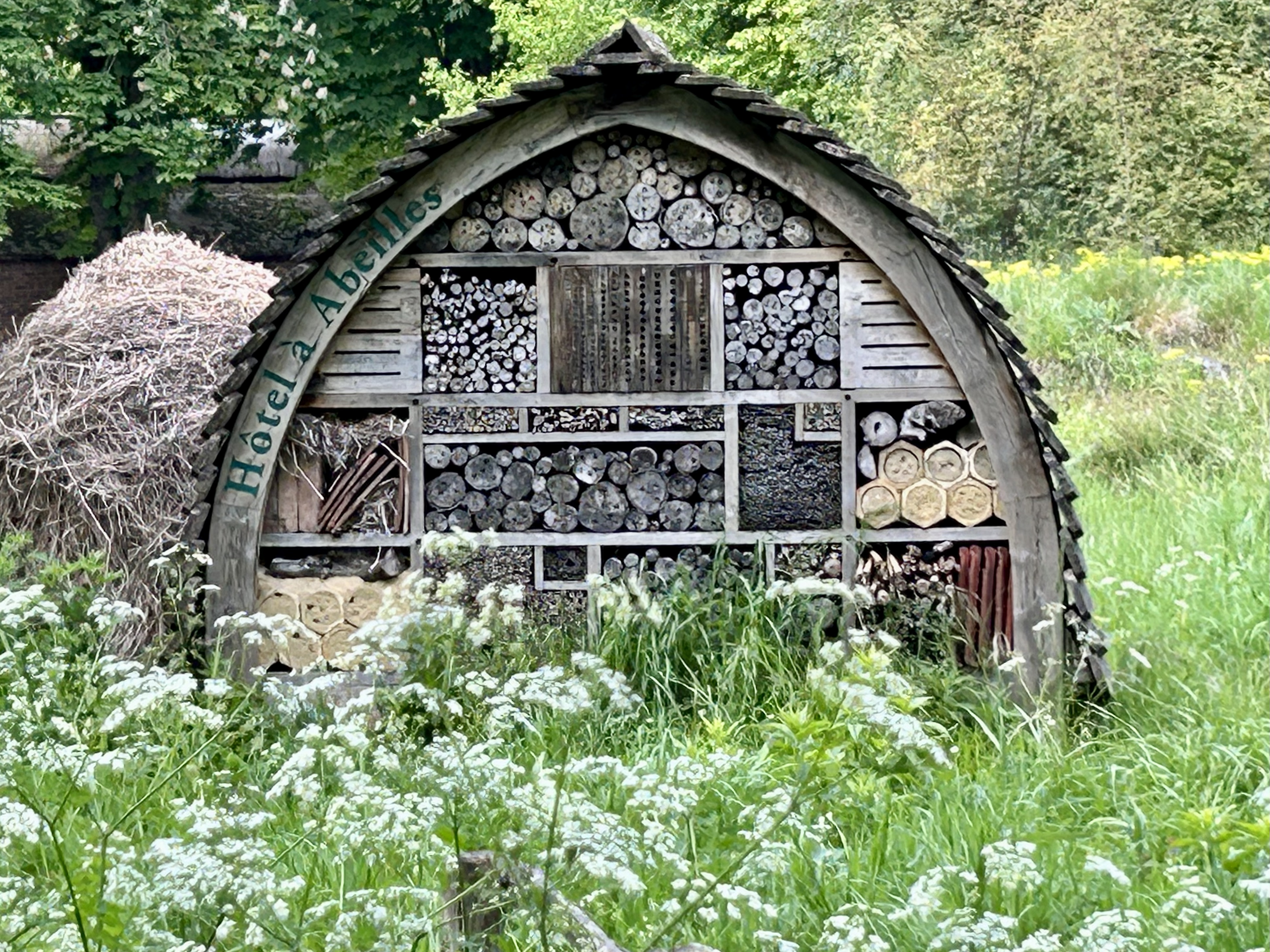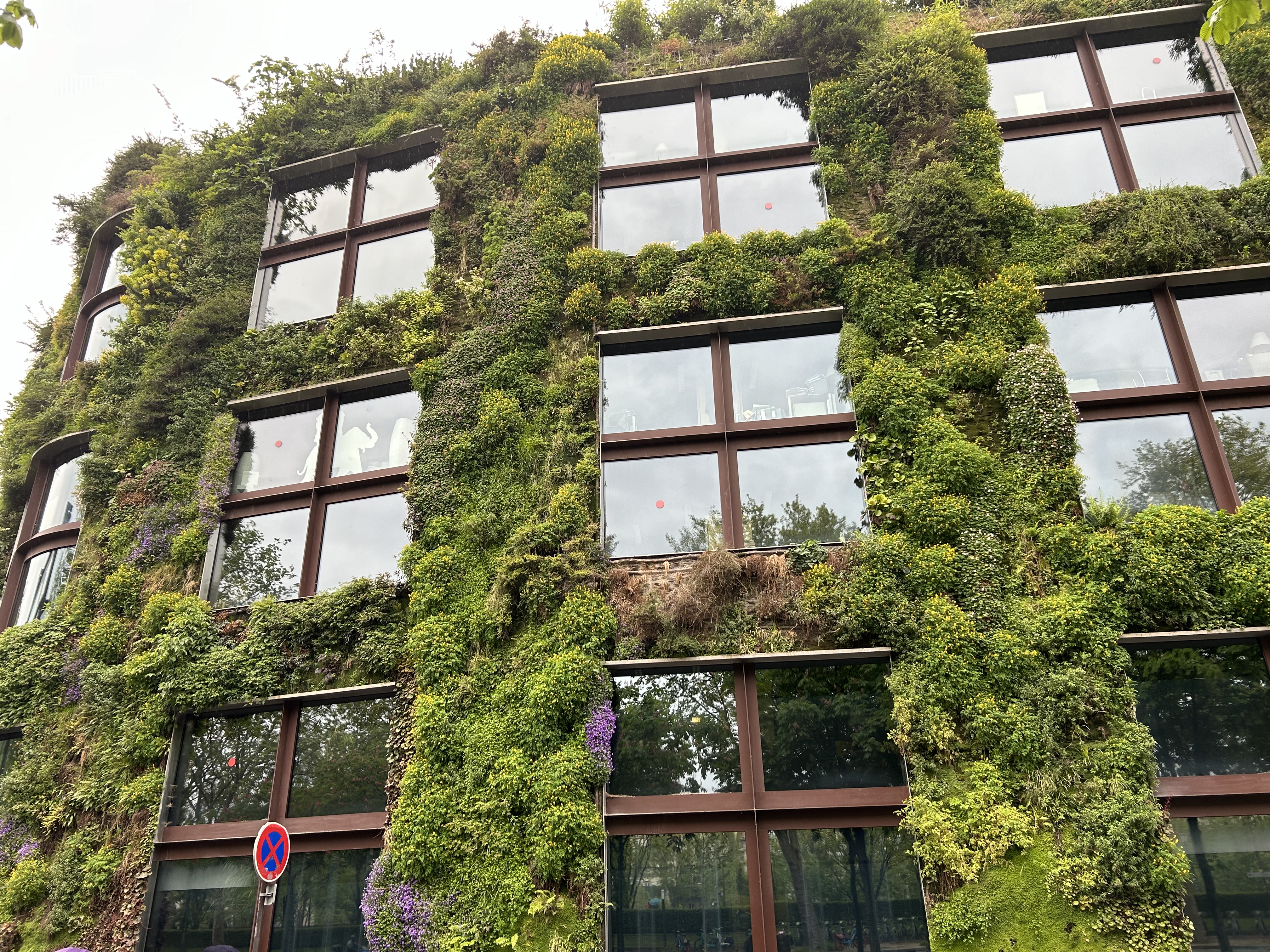I recently returned from a wonderful trip combining France and Italy, reveling in food, history, art, and of course – gardens. In nearly every place we stopped, there were creative, delightful plantings that appreciated and supported nature in a myriad of ways.
On our first day in Paris, as my husband and I blundered through the 5th arrondisement in a jet lag haze, a series of streetside planters spanning half a block stopped me in my tracks. A freestanding iron fence held plastic window box-style troughs in lilac, hot pink, and royal blue. Each was filled with a froth of pollinator-friendly flowers like gaura and erigeron anchored by an evergreen carex or heuchera. Those all happen to be current players in my south-facing Seattle sidewalk aka “hell” strip dealing with compacted soil. It illustrated so simply the power of even the smallest space to make a difference.
 Courtesy Erica Browne Grivas
Courtesy Erica Browne Grivas
A short walk away, the Jardins des Plantes, France’s botanical garden, hosted pollinators with a massive insect house, signage about pollinator plantings, water features, and plantings showcasing varied environments. There is also a Jardin Ecologique (Wild Garden) begun in 1932 (talk about being ahead of the curve!) which is only open by guided tour, so we did not see that.
Just as ancient buildings are designated as “Monuments Historiques,” Paris also celebrates its venerable trees, labeling them as “historic trees” like the bur oak (Quercus macrocarpa) in the Jardins des Plants dating from 1811. Yet two centuries is measly to the black locust (Robinia psuedoacacia) discovered by happenstance on a solo walk on my last day in Paris.
After exploring the Marche aux Fleurs flower market near Notre Dame, enjoying everything from funky garden gifts like Capiz-shell chandeliers, parasols and balloons to hydrangeas, passion-flowers and grevillea, I came upon a small pocket park at Square Rene Viviani, in which QR codes let you hear local birds and learn about “the biodiversity of trees of Paris.” Just as I’m pondering my next move, “Oldest Tree in Paris” pops up on Google Maps – in this park.
According to a plaque the black locust, now braced by concrete buttresses, was planted in 1601 by Jean Robin (for whom the species is named). It explains: “The original tree, now 400 years old, has become several trees welded within a vestige trunk and whose aerial roots develop inside the original trunk. The young trees from its stump and roots have been preserved to ensure its future.”
 Courtesy Erica Browne Grivas
Courtesy Erica Browne Grivas
While Nationalgeographic.com questions the 1601 date it concludes it was planted before 1700. Either way, the city has guarded and nurtured the tree for centuries.
If you have some trees you love, give them a deep drink to counteract the dry two years we’ve had.
According to Agritechture.com, Paris biodiversity is helped along by city ordinance. Beekeeping has become massively popular in Paris, largely because the honey may be healthier in the city than the countryside thanks to municipal bans on using pesticide in city parks, gardens and cemeteries, as well as home terraces and rooftops. We also green buildings covered in plantings, adding habitat and reducing CO2.
The next morning, up early to catch a tour to Giverny and Versailles, we saw insect houses and pollinator plant signage at the Hyatt Regency entry and expansive meadow plantings alongside the nearby highway. I’m not sure if they are related. My husband saw a weedy jumble, but I saw intention and repetition.
I don’t have a lot to report about Giverny and Versailles regarding sustainability, although they had stunning displays of opposite character (intimate, colorful, loosely structured vs. massive, green, tightly clipped). I will say that Giverny, like many of Paris’ public plantings, used a layered tapestry-style planting which filled every cubic inch. The tulips were not battalions standing in bare soil, but skirted by forget-me-nots, primroses and wallflowers for months of shifting color. Are such displays changed out through the season? Probably, but at least the ground is covered in plants. There may be more substantive elements of sustainable culture that weren’t obvious to me, but my tour guide didn’t know from gardens.
Next stop, lively Bordeaux, known for its wine and an excellent antiques market. A beautiful planting follows the riverfront, in several rows surrounded by boxwood. The project, “Flowering Sustainably,” begun nearly 10 years ago in 2015, includes almost 50,000 perennials and 4500 shrubs. Signs were nearly obscured by robust Phlomis italica – a lavender-flowered Spanish native - saying, “Here the city favors plants that are perennial, ecological, diverse, and native.”
If you haven’t tried them, phlomis are wonderful plants for dry-summer regions, which like their sage family cousins, nourish bees and other pollinators. More common here, P. russeliana is the green-leafed, low growing one, while P. fructicosa is the more Hulk-like shrubby variety with silver leaves. Mine is currently attempting, Pac-Man style, to make a sandwich out of our apple tree and ‘Black Lace’ Elderberry (Sambucus).
It’s not surprising that vineyards would pay attention to natural growing methods. We visited one in the Margaux region, where since 2015, growers have collectively implemented a project called “Terroir de Biodiversité,” to preserve the precious and fragile terroir (soil profile) that produces the Medocs famous around the world.
Initiatives serving to reduce the monoculture of the flora and fauna include delayed mowing to foster beneficial insects, hedgerows to nourish pollinators, reducing herbicides, and monitoring species diversity. Over 80% have become certified according to the project website. Interestingly, our tour guide said that Bordeaux region growers are forbidden to irrigate their plots barring government permission in severe drought. This encourages deep rooting and resilient plants, keeping soil salinity down and flavor high.
Which of these ideas can you implement at home? We’ve seen pollinator-friendly windowboxes, showing your trees some extra love (or planting one!), ways to protect your soil, and keep all our food chains healthy by avoiding herbicides and encouraging biodiversity. Italy will have to wait for another column.
Learn More:
https://www.nationalgeographic.com/environment/article/what-we-can-learn-from-paris-oldest-tree-20210713#:~:text=It's%20a%20black%20locust%2C%20Robinia,a%20succession%20of%20French%20kings.
https://margaux-wines.com/sustainable-winegrowing/